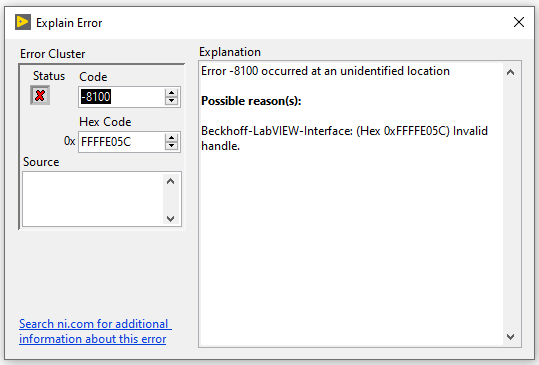Overview of error codes
Error checking in the TF3710 TwinCAT 3 interface for LabVIEW™ product follows the standard LabVIEW™ data flow model. During the execution of LabVIEW™ VIs, error checking takes place at each executed node. The blocks only continue if no errors occur. If an error occurs in a block, it is passed to the next block and the affected part of the function or the block is no longer executed accordingly.
The LabVIEW™ error clusters are used for error checking, which then forwards the following information accordingly:
- Status: a Boolean value that returns TRUE if an error occurred.
- Error code: an error identifier in the form of a signed 32-bit integer. If the error code is not 0 and the status output is FALSE, it is a warning rather than an error.
- Source: specifies the source of the error in the form of a LabVIEW™ string.
The description of the error code can be found in LabVIEW™
Menu > Help > Describe Error.

To avoid collision with existing LabVIEW™ errors, all error codes are described in user-defined error codes. The following error codes may occur when running LabVIEW™ VIs.
error value | See… |
|---|---|
16#FFFF_DE04 - 16#FFFF_DCD9
| Listed in ADS Return Codes (there without high-order WORD). Further information below on this page. |
16#0000_1414 - 16#0000_1432 | Listed in Support Return Codes. |
16#0000_1464 - 16#0000_157C 16#FFFF_E05C – 16xFFFF_DFF9 | Listed in Runtime Return Codes. |
 | If an error occurs during initialization, the function block cannot be used. |
Further information on standard TwinCAT Error Codes:
error value | symbol | Error description | Remedy option |
|---|---|---|---|
16#FFFF_DDFA | NOMEMORY | No memory | Incorrect memory settings |
16#FFFF_DDEB | TIMEOUT | Device has a timeout | A timeout can occur while waiting for feedback or sending a request. This can often be the case if the network is overloaded. With One-time reading or One-time writing the timeout is not so critical, because here the data packet is read or written in one pass. |